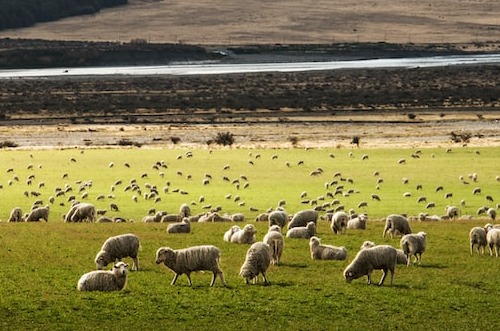
In W24 in the lamb and mutton landscape, Australian sheep and lamb yardings tightened to 37.82 thousand and 135.04 thousand heads, respectively, with New South Wales (NSW) dropping nearly 50% of sheep yarded. Some grain-finished lambs came through large markets such as Wagga Wagga, which helped to improve the condition of heavier lambs. Australian Lamb numbers at the sale yard increased by nearly 11 thousand heads, with shorn lambs fetching better prices. The Restocker Lamb indicator strengthened in price by USD 0.40 WoW, after a strong increase in price at the top contributing sale yards. Ballarat contributed 28% of throughput, with restocker lambs at USD 3.86/kg cwt, USD 0.52 above the national average. As the older season lambs are sold off, mixed quality through the sale yards is driving prices in a less active market. Australian sheep and lamb slaughter also eased in W24, with lambs at only 12 thousand heads above numbers recorded in the same period in 2022. Australian sheep slaughter eased 1% WoW but remained 88% higher YoY. Some Australian plants may be going into their winter maintenance periods, which could have a negative impact on slaughter numbers in the coming weeks.
The Zhejiang Animal and byproducts corporation, is expected to export 10mt of fresh chilled lamb and mutton carcasses in June-2023 from West Australia to the eastern China business and coastal center of Shanghai. The shipment will be the first chilled Australian sheep meat carcass export to China in more than two years, although there have been some chilled cuts consignments in 2023. This follows the import agent, the Zhejiang Animal and byproducts corporation, being granted an import quarantine permit and quota into China for mutton and lamb. Australia and New Zealand have approved suppliers of chilled sheep meat to China. However, according to the MLA, New Zealand has an advantage with more listed plants. Most Australian sheep meat exported to China comprises frozen cuts such as breast and flap, manufacturing, carcass, and neck that are further processed in the market. Australian lamb on the menus of high-end western-style restaurants, five-star hotels, and high-end hot pot establishments has driven growing demand for higher value cuts such as racks, backstraps, and loins. Episode3 indicates that Australia has had a 5-year average of 228mt/year of chilled sheep meat (lamb and mutton) exported to mainland China up to 2020, with nothing in the 2020/21 and 2021/22 financial years, nor so far in 2023. Combined Australian frozen mutton and lamb exports to China totaled about 109 thousand mt in MY 2022 and 120 thousand in MY 2021. In the first four months of 2023, 46.84 thousand mt of frozen lamb/mutton was shipped to mainland China, up by about 40 thousand YoY.
HCC outlines that the 2023 Easter boost helped Australian lamb sales to hold up well during Q1-2023, despite the pressure on household budgets caused by high inflation. HCC further suggests that many Australian shoppers switched from other cheaper proteins, including chicken, to lamb during 2023 Easter. Australian shoppers who were retired or had no children at home contributed to more than half of the growth seen within the lamb category, reinforcing a long-term outlook that Australian lamb continues to be a favorite with the older category of shoppers. From the beginning of 2023 to April 26th, Australian spending on lamb totaled USD 269 million, an increase of almost 6% YoY. This is predictable as inflation has caused the average price of lamb to increase by some 5% YoY to around USD 15.37/kg. However, the total volume of lamb sold is higher by 0.3% YoY, which is relatively stable compared to the same period in 2022. HCC indicates that roasting joints did well over 2023 Easter, with lamb leg roasting joints experiencing a significant increase in the number of buyers, up almost 18% on 2022’s holiday sales period.
Lastly, DAFM reports that 4.01 million sheep were kept across 35,555 registered holdings at the end of 2022 in Ireland, a decrease of 0.35% YoY (14 thousand heads). The 2022 census results showed there were 2.66 million breeding ewes over 12 months of age, a decrease of almost 36 thousand (-1.3%) from the 2021’s breeding ewe population. Irish breeding rams in 2022 amounted to 85.8 thousand, a decrease of over 400 YoY. Also, a total of 1.26 million other categories were recorded (including lambs, wethers, cull ewes, etc.), an increase of over 22 thousand in 2022, up 1.78% YoY. The distribution of the Irish sheep flock in terms of flock sizes has remained relatively stable since 2010, except for the flock size 1–50, where there was an increase of 18% in 2021, with a subsequent decrease by 31% in 2022, returning to a level consistent with previous years. 46.7% of the total sheep population was classified as mountain or mountain-cross breeds, while 53.3% were classified as lowland/lowland-cross breeds. Notably, the Rural Independent Group has been calling for a support payment of USD 32.78/head for sheep farmers that was to be implemented on Jan 1, 2023. During the Brexit period, Irish lamb became the most affordable in the world, while mainland Europe paid USD 32.78-54.63 more than those sold in Ireland.

